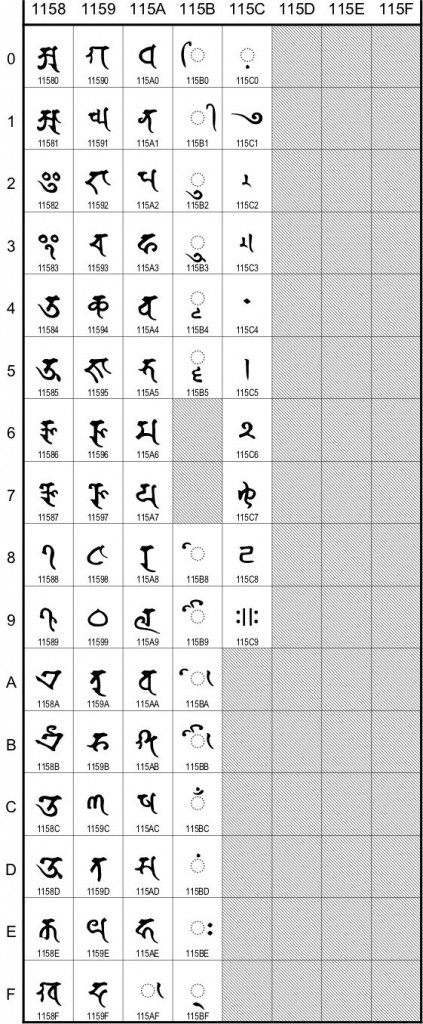Judit Törzsök. ‘The alphabet goddess Mātṛkā in some early śaiva Tantras’. Second International Workshop on Early Tantra, 2009. [PDF]
Rashtriya Skt Sansthan, Saṃskṛtanāṭyaviṃśatikā (2010)
Rashtriya Sanskrit Sansthan. Saṃskṛtanāṭyaviṃśatikā: Twenty best Sanskrit plays in performance. New Delhi: Rāṣṭriyasaṃskṛtasaṃsthānam, 2011(?). 20 videodiscs.
Contents: (1) Jāgarūko bhava (2) Sabhikadyūtakaram (3) Bhagavadajjukīyam (4) Karṇāsvatthāmīyam (5) Cārudattam (6) Campakarāmaḥ (7) Nāgānandam (8) Madhyamavyāyogaḥ (9) Mattavilāsaprahasanam (10) Svapnavāsavadattam (11) Hāsyacūḍāmaṇiprahasanam (12) Pratijñāśvatyāmīyam (13) Abhiṣekanāṭakam (14) Mālavikāgnimitram (15) Tripuradāhaḥ (16) Pañcakalyāṇī (17) Āścaryacūḍāmaṇiḥ (18) Sītācchāyam (19) Ekapātrābhinayaḥ (20) Kauravauravam [sic].

Ōtsuka, *Formation of Early Indian Tantric Buddhism (2013)
大塚 伸夫 『インド初期密教成立過程の研究』 春秋社 (2013/1/31) 23,100円
Ōtsuka, Nobuo. Indo shoki mikkyō seiritsu katei no kenkyū (*Studies on the Formation Process of Early Indian Tantric Buddhism). Tokyo: Shunjūsha, January 31, 2013. 1100 pp. ISBN-13: 978-4393113110 [official site unofficial summary at Taishō U.]
Li, Madhyamakāvatāra 6.1–97 (2012)
李学竹 〈《入中论颂》第六章1一97颂校勘〉 《中国藏学》 1, 2012. (ISSN 1671-6043)
Li, Xuezhu. ‘Madhyamakāvatāra-kārikā’. China Tibetology no.1, 2012, pp.1–16.
Slightly late news, but then this publication doesn’t seem to have been mentioned anywhere else (or brought to my attention) by anyone named in the acknowledgements. That isn’t too surprising, though. One of the three other publications mentioned by the author is an edition of Vasubandhu’s “Viṃśatikākārikā” (p.2), yet one of the nominal collaborators has established back in 2008 that this text should properly be titled Viṃśikā.
Continue reading “Li, Madhyamakāvatāra 6.1–97 (2012)”
Chandrasekhar, Pala-Period Buddha Images (2004)
Chandrasekhar, Chaya. Pāla-Period Buddha Images: their hands, hand gestures, and hand-held attributes. PhD Dissertation, Ohio State University, 2004. xvi+375 pp. [official site / PDF (779.3 MB)]
From the Abstract
This study identifies and classifies the Buddha images of the Pāla period (ca. eighth-twelfth centuries) of eastern India and Bangladesh. Specifically, the study examines the number of hands—whether a single pair or multiple pairs—hand gestures, and hand-held attributes of the Buddha images, and analyzes these elements in relation to the essential teachings of Mahāyāna and Vajrayāna Buddhism. […]
About 963 Buddha images among the known Pāla artistic corpus serve as the primary documents for the study.
Lee, Defining Buddhist art in Bengal (2009)
Lee, Eun-Su. On defining Buddhist art in Bengal: the Dhaka region. PhD Dissertation, University of Texas at Austin, May 2009. 498 pp. [official site / PDF (224.3 MB)]
From the Abstract
This dissertation addresses the significance of regional developments in Indian art, focusing on the Buddhist art tradition of the Dhaka region in East Bengal from approximately the seventh to twelfth century CE.

Johnson, Candrakīrti’s Saṃskṛtārthapratiṣedha (2012)
Johnson, Dennis. ‘Refuting the conditioned: the Saṃskṛtārthapratiṣedha of Candrakīrti’s Catuḥśatakaṭīkā’. Diplomarbeit, Universität Wien (Philologisch-Kulturwissenschaftliche Fakultät), 2012. [official / PDF]
From the Abstract
The original Sanskrit text of CŚṬ is available only in form of fragments that cover about one third of the work, and there is a critical edition of these, based on a single manuscript (Suzuki 1994). A complete Tibetan translation by Sūkṣmajñāna and Nyi ma grags is contained in the bsTan ‘gyur (P. vol. 96, 5266 ya 33b4-273b6; D. ya 30b6-239a7; C. ya 29a6-236a7; N. ya 34b2-246a6).Furthermore, there is an English translation of the verse text (Lang 1986), but not of the commentary, for which there are but translations of single chapters into different languages (Lang 1976 and 2003; Tillemans 1990 are the English ones).
The thesis further contributes to this work by presenting a translation and summary of the hitherto unaddressed chapter of CŚṬ XV, on the basis of the remaining Sanskrit text (in this case CŚṬ XV.18-25) and a critical edition of the Tibetan translation.
Pandey’s Siddham Script in Unicode proposal (2012/8)
Anshuman Pandey. ‘Proposal to Encode the Siddham Script in ISO/IEC 10646’.
ISO/IEC JTC1/SC2/WG2 N4294 L2/12-234R. PDF. 2012/08/01.
Mr. Pandey’s proposal – now no longer preliminary – promises to fill yet another gaping hole in the standard encoding of important Indic scripts. Now would be an appropriate time to comment, if you haven’t already commented.
(I would hope, at minimum, for the addition of a full set of ten digits in the final proposal. Often such basics fall through the gaps because the corpus of readily available primary material is so limited. Here‘s a nice “7-8th century” bilingual manuscript with a varṇamālā (no digits, though) which is both in good condition and readable online, thanks to the care of its Japanese custodians. Incidentally, this clearly confirms that two of the “Punctuation and ornaments” in Pandey’s Fig. 33 are ornamental final anusvāra [अं字].)
Comments should be emailed to Anshuman Pandey, whose address is given in the N4294 proposal (link above) and at the bottom of his personal website (link).

von Criegern, ‘Das Sarvadharmaguṇavyūharājasūtra’ (2009)
Oliver von Criegern. ‘Das Sarvadharmaguṇavyūharājasūtra: ein Mahāyānasūtra zum Buchkult aus den Gilgitfunden’. München Univ., Diss., 2009. 237 pp. [unseen]
Li, ‘Candrakīrti’s Āgama’ (2012)
Li, Shenghai 李勝海 [academia.edu]. ‘Candrakīrti’s Āgama: A Study of the Concept and Uses of Scripture in Classical Indian Buddhism’. PhD diss., University of Madison-Wisconsin, 2012. 311 pp.
From the Abstract
This dissertation examines scripture as a concept and the various roles that authoritative Buddhist texts play as such in the intellectual history of Buddhism. While it considers what Buddhist authors explicitly speak about scripture, the project brings into focus the recorded uses of authoritative texts, with an interest in discovering intellectual practices and learning about the management and transmission of knowledge. The main source materials of this study consist of instances of scriptural references found in the scholastic and commentarial works of several influential Indian and Tibetan authors, all of whom are connected with the pivotal figure of Candrakīrti (ca. 570-640), whose major writings lie at the center of the investigation. […]
Highlighting a keen awareness of the problem of reifying reason displayed by certain Buddhist writers from the Madhyamaka School of thought, the dissertation argues more specifically that the Buddhist scholastic tradition is cognizant of the hermeneutical condition of understanding and of reason’s contingency upon language, context, and tradition.

